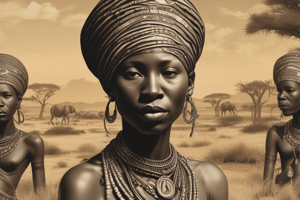Podcast
Questions and Answers
What process involves introducing a new idea in culture?
What process involves introducing a new idea in culture?
- Innovation (correct)
- Diffusion
- Enculturation
- Cultural shock
Which term describes the belief that one's own culture is superior to others?
Which term describes the belief that one's own culture is superior to others?
- Subculture
- Cultural relativism
- Ethnocentrism (correct)
- Xenocentrism
What is it called when cultural items spread from one society to another?
What is it called when cultural items spread from one society to another?
- Diffusion (correct)
- Cultural lag
- Socialization
- Integration
Which aspect of cultural variation specifically involves opposing larger cultural norms?
Which aspect of cultural variation specifically involves opposing larger cultural norms?
What type of cultural change is often associated with tangible elements such as landmarks?
What type of cultural change is often associated with tangible elements such as landmarks?
Which of the following best describes the concept of culture shock?
Which of the following best describes the concept of culture shock?
In what ways can heritage provide significance to contemporary culture?
In what ways can heritage provide significance to contemporary culture?
Which term refers to the assimilation of one culture into another, leading to a blending of customs and practices?
Which term refers to the assimilation of one culture into another, leading to a blending of customs and practices?
What is the primary way culture is transmitted within a society?
What is the primary way culture is transmitted within a society?
Which characteristic of culture indicates that it can evolve based on changes in the environment?
Which characteristic of culture indicates that it can evolve based on changes in the environment?
Which element of culture encompasses systems of symbols used for communication?
Which element of culture encompasses systems of symbols used for communication?
What does the term 'deviance' refer to in the context of cultural norms?
What does the term 'deviance' refer to in the context of cultural norms?
In which domain does the study of power within society primarily fall?
In which domain does the study of power within society primarily fall?
What is a key aspect of the mutual stimulus and response network in society?
What is a key aspect of the mutual stimulus and response network in society?
Which term describes the collective set of beliefs, values, and experiential frameworks shared among a group?
Which term describes the collective set of beliefs, values, and experiential frameworks shared among a group?
Which of the following is an example of non-material culture?
Which of the following is an example of non-material culture?
Flashcards are hidden until you start studying
Study Notes
Society and Culture
- Society is a group of individuals sharing a common culture, formed by mutual interactions and emotional responses.
- Trade involves the sharing and exchanging of cultural elements among individuals.
- Society encapsulates aspects of Anthropology (traditions), Sociology (interactions), and Political Science (power dynamics).
Characteristics of Culture
- Culture represents the way of life, encompassing experiences, beliefs, values, and religions.
- Ideas include thoughts, emotions, and rules, whereas activities cover celebrations, punishments, and sports.
- Artifacts are human-made products reflecting cultural ideas and are part of material culture.
- Culture is learned through interactions and experiences, indicating the importance of social engagement.
- Culture is shared, enabling collective understanding and cultivation of values within a group.
Elements of Culture
- Culture is diverse, dynamic, cumulative, and sometimes contested.
- Material culture includes physical items, while non-material culture comprises concepts such as language and values.
- Language serves as a symbolic system facilitating understanding among individuals.
- Norms guide acceptable behavior, categorized into formal (written) and informal (understood) norms.
- Beliefs are core ideas held by individuals, while fashion represents transient social norms like clothing trends.
Process of Cultural Change
- Cultural change results from innovation (introduction of new ideas), diffusion (spread of culture), and adaptation to environments.
- Enculturation allows the learning of one culture by another, while socialization is the ongoing interaction with a culture.
- Integration signifies full adoption of new cultural elements into an individual's life.
Cultural Variation
- Subcultures exist under a broader culture, showcasing variations such as ethnic or social class differences.
- Counterculture opposes mainstream cultural aspects, while culture shock occurs when individuals feel out of place in a new culture.
- Cultural lag reflects the difficulty of adapting to rapid societal changes, whereas cultural universals are common features across cultures.
Attitudes Toward Culture
- Ethnocentrism denotes the belief in the superiority of one's culture, leading to misunderstandings of unfamiliar cultures.
- Xenocentrism represents viewing one’s culture as inferior compared to others, while cultural relativism promotes understanding and respect for diverse cultures.
Heritage
- Heritage encompasses valuable elements from the past that shape identity and inspire future generations.
- Tangible heritage includes landmarks like historical sites, while intangible heritage consists of traditions like folk dances.
- Examples of heritage items feature natural stories (like Mt. Makiling), built structures (e.g., UST’s main building), and movable items (like literature about Juan Luna’s life).
Significance of Heritage
- Heritage holds historical, architectural, aesthetic, scientific, social, and symbolic value.
- Historical significance is tied to events, such as Aguinaldo Shrine; architectural importance reflected in places like Vigan City.
- Aesthetic components are represented by sites like Manila Metropolitan Theater.
- Scientific heritage, such as UST Main Building’s earthquake-proof design, enhances community life, while social heritage includes communal places like Quiapo Church.
- Symbolic heritage includes places that resonate with national sentiment, like EDSA Shrine.
Studying That Suits You
Use AI to generate personalized quizzes and flashcards to suit your learning preferences.




